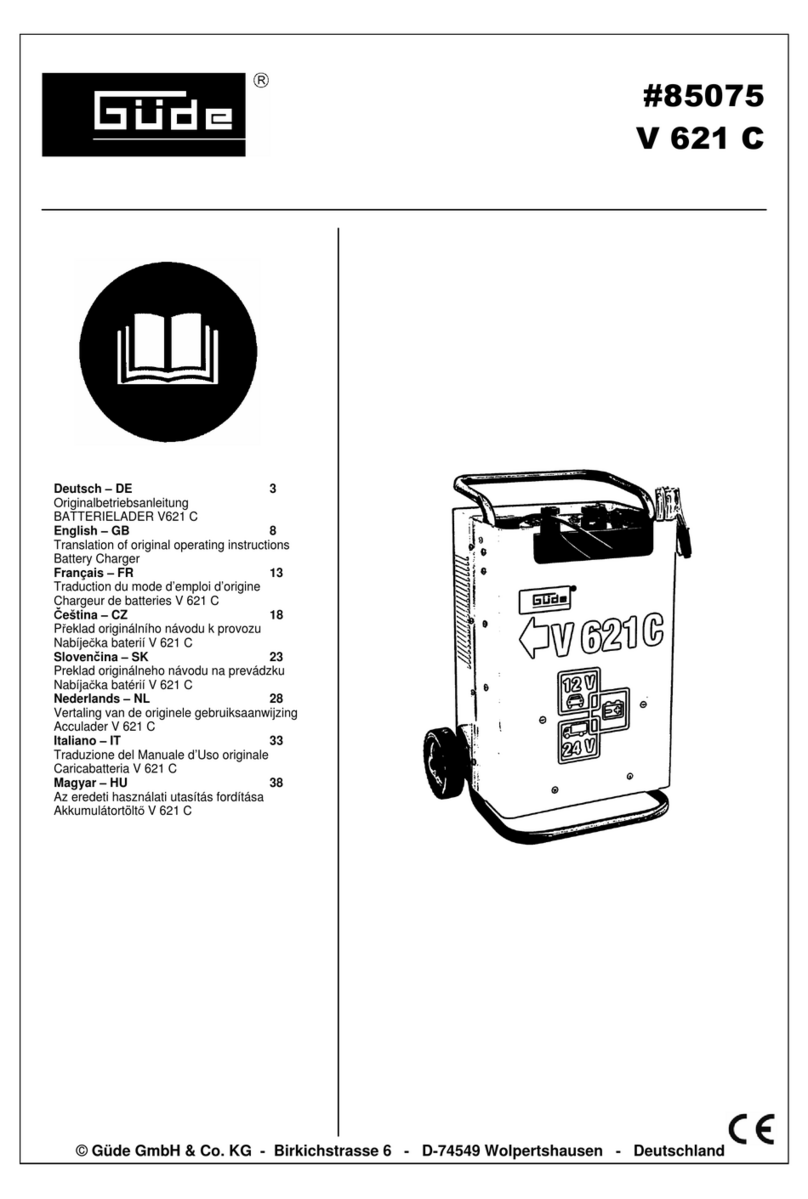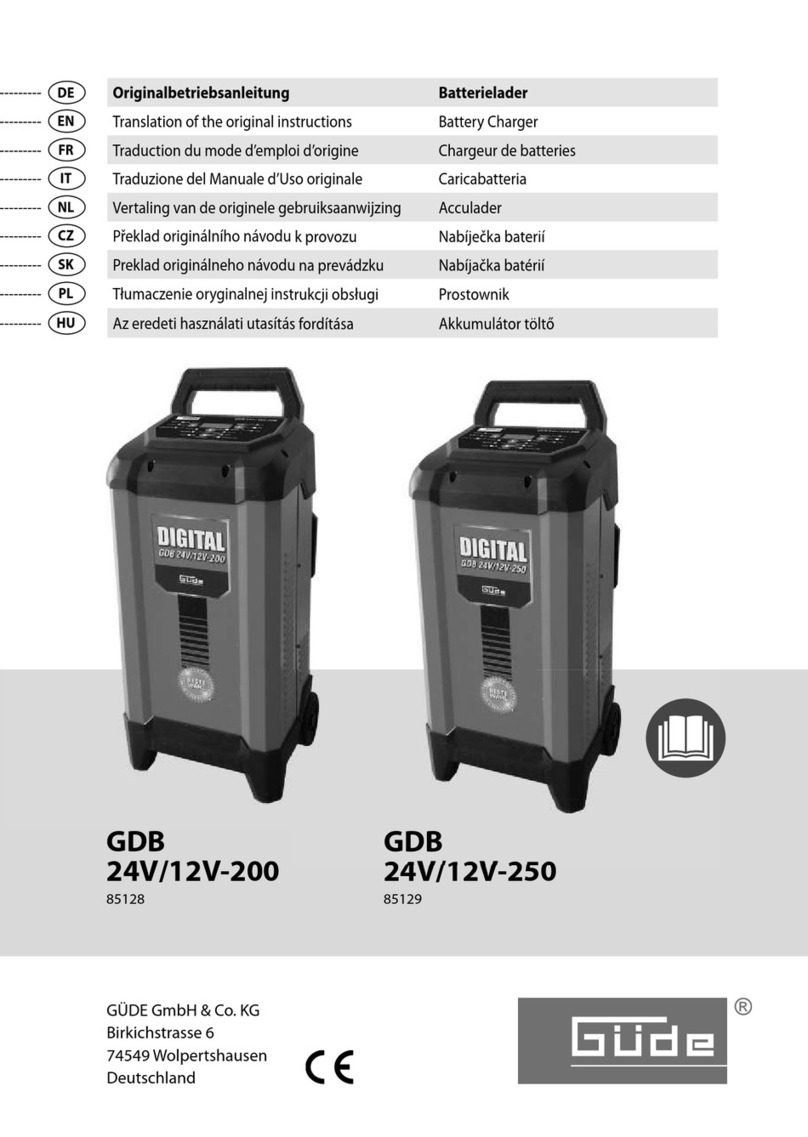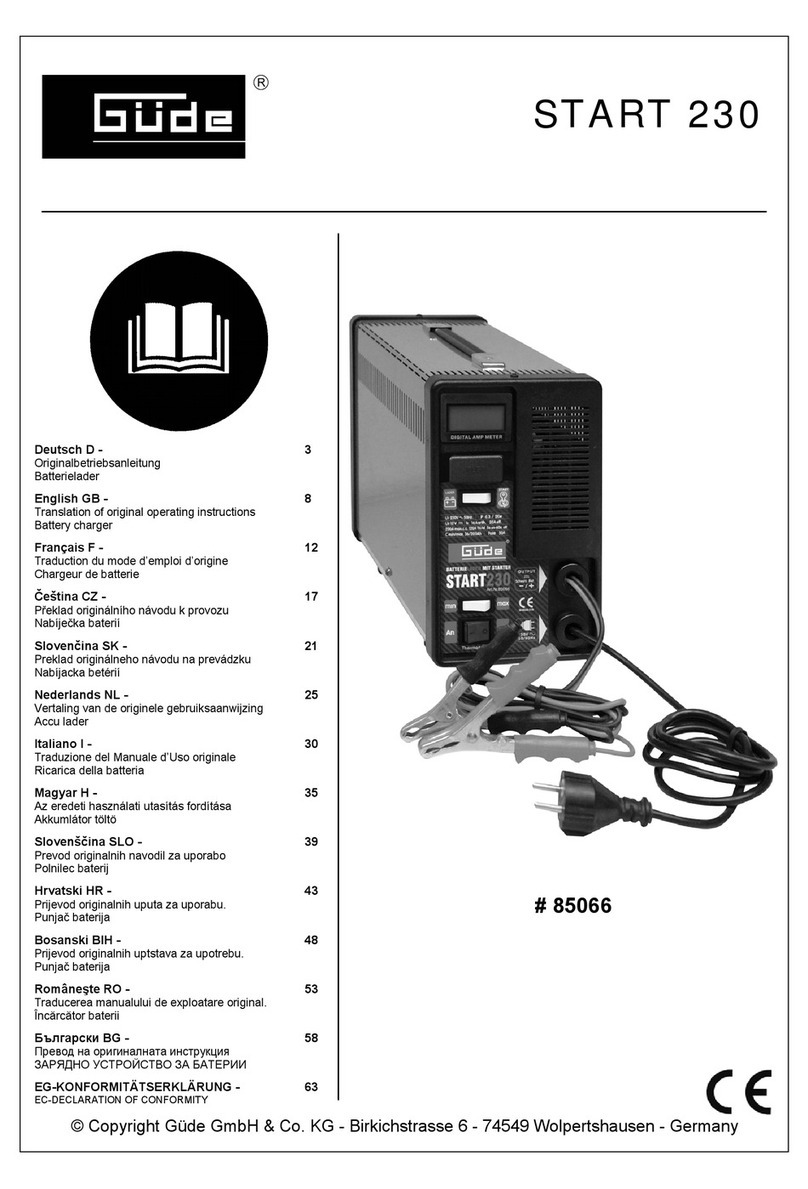Gude V 621 C Wiring diagram

#85075
V 621 C
© Güde GmbH & Co. KG - Birkichstrasse 6 - D-74549 Wolpertshausen - Deutschland
English – GB
Translation of original operating instructions
Battery Charger V621 C

2
3
5
4
1
2

GB Please read carefully these operating instructions before putting the machine into operation.
A.V. 2 Reprints, even partial, are subject to approval. Technical changes reserved..
GB
Do you have any technical questions?Any claim?Do you need any spare parts or operating instructions?
We will quickly help you and without needles bureaucracy at our web pages at www.guede.com in the Servicing part. Please help us be able
to help you. In order to identify your device in case of claim we need the serial No., product No. and year of production. All this data can be
found on the type label. Please enter it here for future reference:
Serial No.________________________________Product No.:__________________________Year of production______________________
Tel.: +49 (0) 79 04 / 700-360 Fax: +49 (0) 79 04 / 700-51999 E-Mail: [email protected]m
Devise
Battery Charger V 421 C
Professional charger for charging, high-rate charging and
starting of vehicles. Mobile due to big wheels and practical
handle.
Scope (Fig. 1+2)
1. Wheels
2. Axle
3. Screws
4. Wheels covers
5. Handle
6. Charger
Description of Unit (Fig. 3)
1. connection 12 V
2. ground
3. connection 24 V
4. cut-out fuse
5. ammeter
6. Charging/start tap changer
EC Declaration of Conformity
We,
Güde GmbH & Co. KG
Birkichstraße 6
74549 Wolpertshausen
Germany
hereby declare the conception and construction of the below-
mentioned devices correspond - at the type of construction
being launched - to appropriate basic safety and hygienic
requirements of EC Directives.
In case of any change to devices not discussed with us
the Declaration expires.
Marking of devices: V 621 C
product No: 85075
Appropriate EC Directives:
2006/95 EG
2004/108 EG
Harmonised standards used:
EN 55014-1: 2006
EN 55014-2/A2 :2008
EN 61000-3-2: 2006
EN 61000-3-3: 2008
EN 61000-3-11: 2000 *
EN 60335-2-29 : 2004
Certification body:
TÜV SÜD Product Service GmbH, Ridlerstrasse 65,
80339 München, Deutschland
Date/producer signature: 25.08.2010
Angaben zum Unterzeichner: Mr. Arnold,
executive officer
Technical Documentation: J. Buerkle FBL; QA
* The appliance meets EN 61000-3-11 requirements and is
subject to special connection conditions. That means that use
on optionally selected connection points is inadmissible.
The appliance can lead to occasional voltage fluctuations
under unfavourable power conditions.
The appliance is only designated to be used for connection
points not exceeding the maximum allowed impedance of Zmax
= 0,233 Ω.
As a user, you must make sure your connection point on which you
want to use the appliance meets the above-mentioned requirements –
after agreement with your electricity supplier if necessary.
Guarantee
The guarantee solely covers inadequacies caused by material
defect or manufacturing defect.
Original payment voucher with the sales date needs to be
submitted for any claim in the guarantee period.
The guarantee does not cover any unauthorised use such as
appliance overloading, use of violence, damage as a result of
any unauthorised interference or caused by foreign items.
Failing to follow the operating and assembly instructions and
common wear are also not included in the guarantee.
General Safety Regulations
This instruction manual should be read carefully before the
initial use of the unit. If in doubt with regard to connection and
operation, contact the manufacturer (servicing department).
Observe the instructions below carefully to provide for a
high degree of safety:
Warning: Do not operate unless with current
protection (FI) fitted!
Caution!
•Keep your workplace clean and tidy. Messy
workplace and disorder on the table increase the risk of
accident and injury.
•Mind the conditions of the environment you work in.
Do not use electric tools in moist and wet surroundings.
Provide for sufficient lighting. Do not expose the electric
tools to the rain or high atmospheric moisture. Do not
switch on in an area containing inflammable liquids or
gases.
•Do not admit any strangers to the machine. Visitors
and bystanders, children and the sick in particular keep
at a sufficient distance from your workplace.
•Provide for safe storage of the tools. The tools that
are not in current need should be stored at a dry
unapproachable or an elevated place.
•Watch out for the cable. Do not pull the cable. To
unplug, always grasp at the plug. Keep the cable at a
safe distance from sources of heat, oil and sharp edges.
•Provide against unintentional switching. Always
make sure that the tool switch is in OFF position before
plugging in.
8

•When working outdoors, use special extension
cables. To work outdoors, special extension cables are
needed, mark in the appropriate way.
•Always remain concentrated. Mind what you are
doing. Use common sense. Do not use electrical tools
when feeling tired. .
•Watch out for damaged parts. Check out the unit
before use. Are some parts damaged? If the damage is
slight, reconsider whether the unit is able of perfect and
safe operation.
•Prevent any electrical shock. Avoid any contact of
your body with grounded articles, e.g. water piping,
heating radiators, stoves and fridges.
•Use approved parts only. For maintenance and
repairs, use genuine spare parts only. The spare parts
may be obtained from an authorised servicing centre.
•Warning! Use of accessories and additional parts other
than those recommended in the operating manual may
present a threat for persons and things.
Initial Operation Safety Instructions
•Before starting set-up or maintenance of the unit,
disconnect it from the source.
Connect the charger until the power supply, if all
the settings and the terminals are properly connected.
•Having removed the packing, make sure that the
condition of the unit and any of its component is perfect.
•Unwind the power cable completely and put it so the
pole terminals cannot get in touch with each other.
•If necessary, use an extension cable to extend the
power cable; it must be of the same cross section as the
power cable. Never use cable of smaller cross section.
•Keep the clamps, terminals and upper surface of the
battery clean, if necessary, use the wire brush to clean
the battery terminals. In this way, a good electrical
contact will be provided and better charging efficiency
secured.
•Never mix connections poling! ( (-) black; (+) red )
•The charging voltage should be same as that shown on
the battery i; the value is equal to the number of cells of
a storage battery multiplied by two (3 cells = 6 V; 6 cells
= 12 V; 12 cells = 24 V).
•Before charging, put the unit on a stable base and make
sure that noting will prevent air flow through the
respective holes. A good cooling system must be
guaranteed.
•Do not charge more batteries at a time.
•The battery closure should be removed after cleaning
the terminals not to have dust and dirt falling in the tubs.
•Provide for the electrolyte covering the plates up to the
height of 4-5 mm at least, If necessary, add distilled
water that may be obtained at shops for this purpose.
•In the course of charging, explosive gases develop
abstain from smoking and naked fire or sparks.
•The batteries should be charged in well ventilated
spaces. The charger is prohibited for use inside a
vehicle or closed car bonnet.
•Never charge standard and maintenance-free batteries
jointly.
•Never recharge disposable batteries.
•Leave sufficient ventilation space behind the unit.
•Follow the manufacturer’s instructions.
•Check ion the right level of the acid Kin battery. .
•Always check whether condition of the power cable and
clamping cable is perfect. If the power cable is
damaged, have it replaced at a specialist’s.
•The unit should not be exposed to weather effects –
snow and rain.
•Do not use the unit bare footed. Do not touch the unit
with wet or damp hands or feet .
•Never unplug by pulling the cable.
•Prevent unauthorised persons or children from using the
unit.
•Apply in use, always gloves and eye protection and
be alert when working with acid!
Do not leave the switched-on unit unattended, it
could become a source of risk.
•If you do repairs of safety or protection devices, they
should be refit immediately after the job is completed.
•Injuries prevention regulations effective at a place of
particular use and any other generally recognised safety
rules must be known and observed.
•The safety devices should be checked on before the use
of unit. Make sure that even the parts, which are slightly
damaged seemingly, may work properly. .
•Unless otherwise stated in this manual, repairs and
replacement of damaged components and safety
devices should be done at an authorised servicing
centre.
•Have any damaged switches replaced at an authorised
servicing centre.
•This unit complies with any respective safety provisions.
The repairs are allowed to be done by skilled electricians
at authorised servicing centres only. Only genuine spare
parts may be used. A risk of injury is imminent if the
regulation is not observed.
Behaviour in case of emergency
Provide necessary first aid treatment corresponding to the
injury nature and seek qualified medical help as soon as
possible. Protect the injured person from other injuries and
calm him/her down. First aid kit must always be available
in the place of your work in case of accident in
accordance with DIN 13164. Material taken out of the first
aid kit needs to be supplemented right away. If help is
needed, please provide the following details:
1. Place of accident
2. Accident nature
3. Number of injured persons
4. Injury type
Meaning of Symbols
Symbols shown below are used throughout this manual
and/or on the unit:
Product Safety:
Product compliance with
respective EU standards There is protective insulation on
the unit.
Bans:
General ban (in combination with
another pictograph) Do not use the unit in rain
No pulling the cable
Precaution:
Warning/caution Beware of hazardous voltage
9

Warning against caustic
substances
Commands:
Read operating manual before use Use protection gloves
Use vision protection aids
Environment Protection:
Wastes to be disposed of in a
professional manner not to harm
the environment.
Cardboard packaging to be
collected for recycling.
Faulty and/or disposed of
electrical/electronic appliances to
be collected by authorised salvage
places.
Packaging:
Protect from moisture Keep Up
Interseroh
Technical Data :
Power connection Maximum output
Min. protection Charging voltage
Battery capacit Max. effective charging current
Weight
Assigned Use
Starting charger to charge, quick-acting charging and vehicle
start up. Large wheels enable good travel. Lead battery:
onboard electronics will get damaged at batteries connected
to the vehicle if started for more than 7-10 seconds. Lead acid
batteries to be used only.
Residual Electrical Hazards
Direct electrical contact
Defective cable one plug may cause an electrical shock
injury.
Have the defective cables and plugs replaced at a
specialist’s. Use the unit on a connection equipped with a
current protection (FI).
Indirect electrical contact
A risk of injury by conductive parts with open or
defective parts of the unit
Disconnect the unit from the source of power to maintain it.
Operate with a current protection only.
Insufficient Lighting of Workplace
Insufficient lighting always present a high safety risk.
Always provide for sufficient lighting when working with the
unit.
Disposal
Disposal instructions are illustrated in the form of pictograms
on the device or packaging. Description of the pictograms is
given in "Identification" chapter.
Disposal of transport packaging
Packaging protects the device against damage during
transport. Packaging materials are usually selected according
to their effect on environment and disposal methods and can
therefore be recycled.
Returning of the packaging back to circulation saves
resources and costs for packaging disposal.
Parts of the packaging (e.g. foil, styropor) may be dangerous
for children. Risk of suffocation!
Keep these parts of the packaging out of reach of children
and dispose as soon as possible.
Qualification
No special qualification is required for use of the unit except
for detailed direction by a professional.
Minimum Age
Only persons above 16 years of age are allowed to work with
the unit. .
Exempted from the provision is the use of the juvenile
trainees if they work in the course of their professional training
with an aim to obtain the skill under trainer supervision
Training
Use of the unit requires adequate lesson by a professional or
the use of the manual only . Special training is not required.
Technical Data
Connector: 230 V~50 Hz
Charging voltage at start: 12 V/24 V
Max. input when starting: 9000 W
Charging rms current: 70 A
Charging arithmetic current: 50 A
Starting current (0 V) app.: 500 A
Starting current (1.5 V) app.: 300 A
Min. protection: 16 A
Auxiliary fuse: 110 A
Rated capacity: 20-800 Ah.
Weight: 23 kg
Transportation and Storage
•If putting the unit away for a prolonged storage, it should
be cleaned thoroughly.
•Protect the unit from weather effects with a tarpaulin,
carton etc.
Assembly and Initial Operation (Fig. 4+5)
A
10

Screw on the handle according to (Fig. 4).
Put the axle through the charger (Fig. 1/2). Fit the supplied
safety rings on. Mount the wheels (Fig. 1/1) on the axle and
secure them with safety rings (Fig . 5).
Put the wheels covers (Fig. 1/4) on.
Operation
Unplug before any adjustment and set up.
Charging (Fig .3)
•Connect the charger to the battery to be recharged
•Always connect the black cable first, to the negative pole.
Connect the red pole cable to the positive pole.
The battery should be completely disconnected from the
vehicle before getting down to charging.
•Always set the charger at the lowest charging degree
(min/1).
•Now, plug in and control the charging degrees upwards
until charging current equal to ca 10% of the battery
capacity is displayed.
•Charging degrees may be increased by falling charging
current.
•Do not disconnect the battery from terminals later than
3-5 hours after charging is finished.
•Notice. The charging current indicator will not
come back to zero after charging is finished.
Charging Time
•The charging time always depends on the battery status
(nearly charged, half-charged or completely discharged)
•To recover a battery that is normally in use 2 – 4 hrs are
sufficient, while for full recharging 8-10 hrs are needed.
•Charging time should not be exceeded (10 hrs
max.).
High-rate charging
4-6 levels allow high-rate charging that must in any case be
limited by a timer.
-Connect the battery (see the “Handling“ chapter).
-Set the charging level optionally to 4-6 and read the
charging current on the ammeter.
-Set the timer to the required charging time (max. 60
minutes).
Start-up Assistance
•CAUTION! At the startup process can overvoltages
arise, the on-board electronics could damage their
vehicle. Please discuss with your automotive specialist.
•Connect the batteries as shown in part “Charging” and
leave it connected to the vehicle!
•On principle, two persons should always start up a
vehicle with chargers.
•The charger on max. Performance are:
Switching stage 2 (Fig. 3, 7) and "boost" (Fig. 3, 8).
•The first person shall push the Start button on the
charger (Fig.3, 9). The other one shall immediately start
the ignition, max. 9-10 sec.
•As the vehicle starts up, stop starting immediately
•If the attempt to start fails, wait about 5 minutes for the
charger to get cooled and only then begin another
attempt to start.
Tip: If you change the battery for 10-15 minutes to
subpoena requires much less battery power startup.
Warning: The fuses may burn through and the
vehicle damaged if the starting time is more than 10 s.
Note: The terminals may not touch.
Notice: The charger is equipped with overload
protection.
IMPORTANT NOTICE!: Replacement fuses, the resistance
values (Fig. 3,5) of which are dirrerent from the plate
values, may cause material and personal damage. The
fuses replacement should not be done unless the mains
cable is unplugged
Operator Safety Instructions
•Any safety and protection devices must be fitted in
place before switching the unit on.
•It is forbidden to attempt starting vehicles, the batteries
of which are discharged or damaged as that would
result in damaging the unit.
•Any attempts to start in position “charging” instead of
“starting” could damage the ammeter and start the
overload protection.
•Before pressing the main switch, make sure that the
unit is connected correctly.
•Warning! If in doubt, consult a specialist in an
authorized servicing centre.
•Do not use the unit until you have read the manual
carefully.
•Observe all the safety regulation in this manual.
•Be responsible to the others.
Step-by-step Instruction
Charging
1. Connect the charger .
2. Set the charging function up (min/1).
3. Switch the charger on .
4. Plug in .
5. Battery is being charged. (max. 10 hrs)
Starting
1. Connect the charger .
2. Set the starting up (Fig.3/6).
3. Connect to the mains ě.
4. Switch the charger on and start the vehicle immediately.
5. Jas soon as the vehicle is up, stop starting and switch off
and disconnect the charger.
Troubles-Causes-Troubleshooting
Notice: Always check the overload protection first!
Overload circuit-breaker:
1. Connect the red clamp to the positive pole and the black
one to the negative pole.
2. Remove the contact and check the fuses.
3. Set the charger at the lowest charging degree. .
4. If the battery power input is too high, it is recommended
to have the battery charging done by a skilled electrician
and to keep the level of charge high by frequent
charging or to get a more powerful charger.
Have the battery checked by a specialist. Replace the
battery.
Too heavy charging current at the beginning of charging
1. Watch out the charging current if it is high even after 15 -
20 minutes, it may mean that the charge would not hold
Have the battery checked at a specialist’s. Replace the
battery.
Too weak charging current .
1. Try to adjust the charging current control higher.
Ammeter pointer touches the lowest position of the scale
1. Have the battery checked at a specialist. Replace the
batteries
11

2. Ensure that the mains voltage is equal to the desired
value
Ammeter does not indicate.
1. Clean the terminals and put the clamp on again.
2. Have it checked at a specialist´s . Replace the battery.
Check on the charger working ability on a perfect
charged battery.
Overload Causes
1. Mixing up the poles when connecting the clamp to the
battery
2. The battery is heavily or completely discharged.
3. Battery is completely discharged and its capacity is
higher than the charger power
4. Battery is damaged or defective (internal elements short
circuit).
Inspections and Maintenance
Unplug before any work on the unit.
•Use a wet cloth to clean the plastic parts. Do not use
detergents, solvents and sharp articles.
•Use a soft brush or a paint brush to remove the settled
dust from the vent and moving parts.
•Lubricate the wheels regularly!
Inspections and Maintenance Safety Instructions
After every use
Clean the vents and moving parts from dust
Regularly
Oil the moving metal parts (multi-purpose oil)
Regularly
Check all the screws to see if they are tight.
12
Other manuals for V 621 C
1
This manual suits for next models
1
Table of contents
Other Gude Batteries Charger manuals
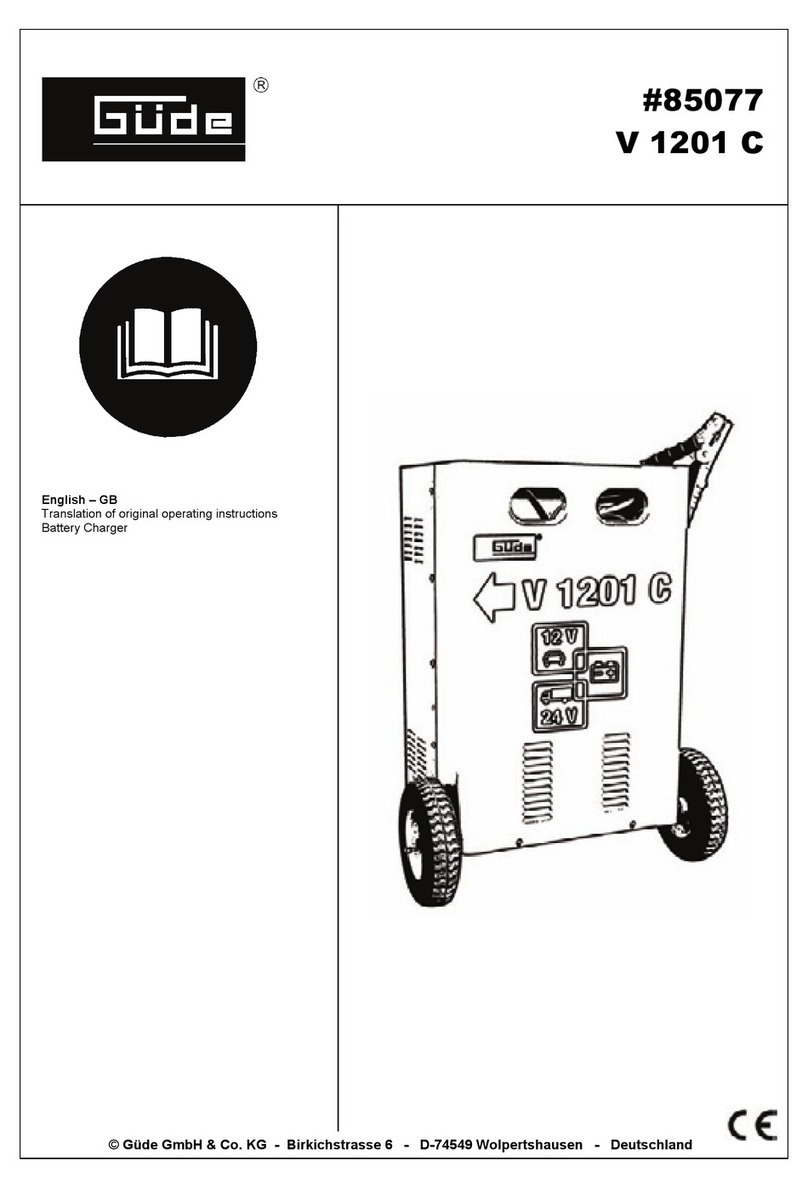
Gude
Gude V 1201 C Wiring diagram
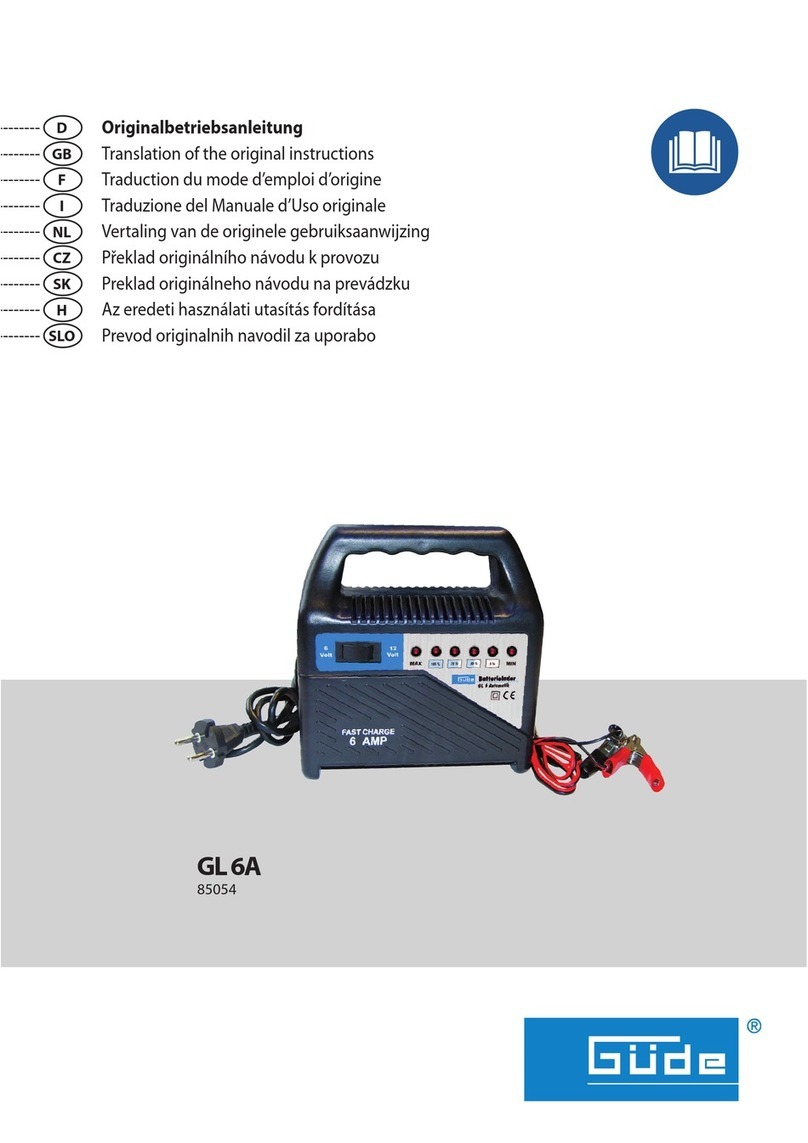
Gude
Gude GL 6A User manual
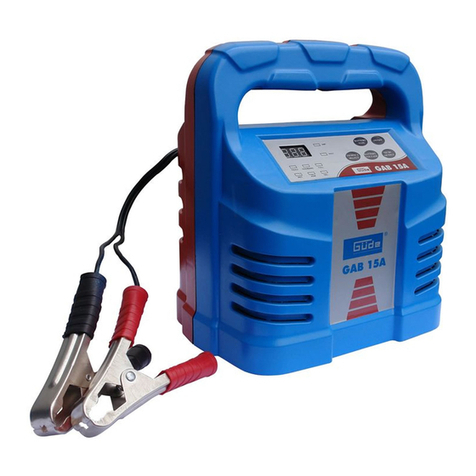
Gude
Gude GAB 8A Wiring diagram
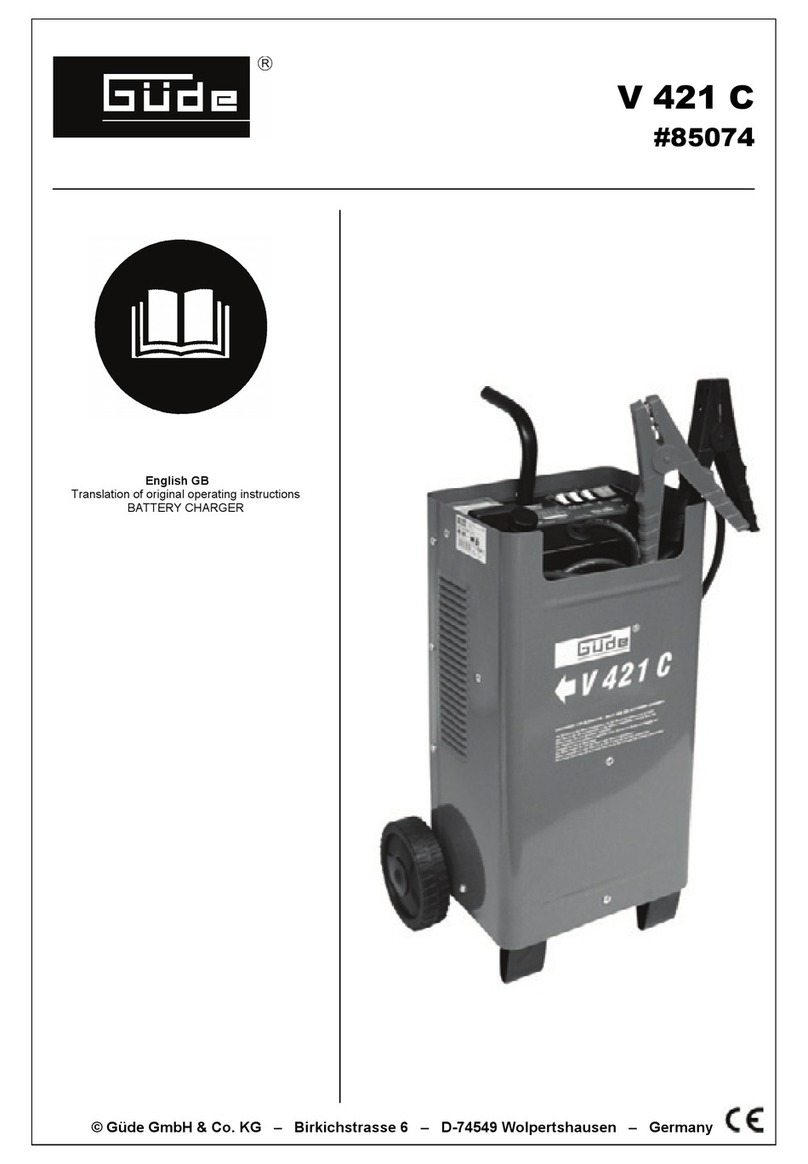
Gude
Gude V 421 C Wiring diagram
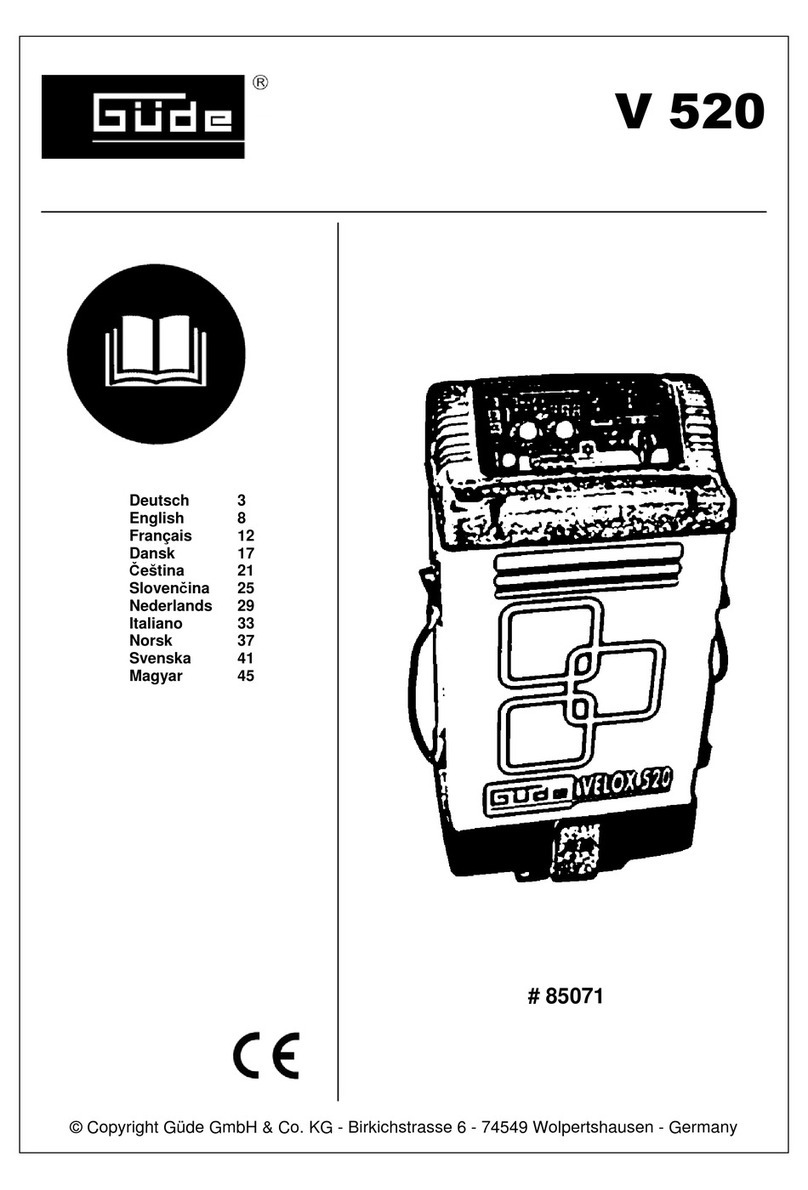
Gude
Gude Velox 520 User manual
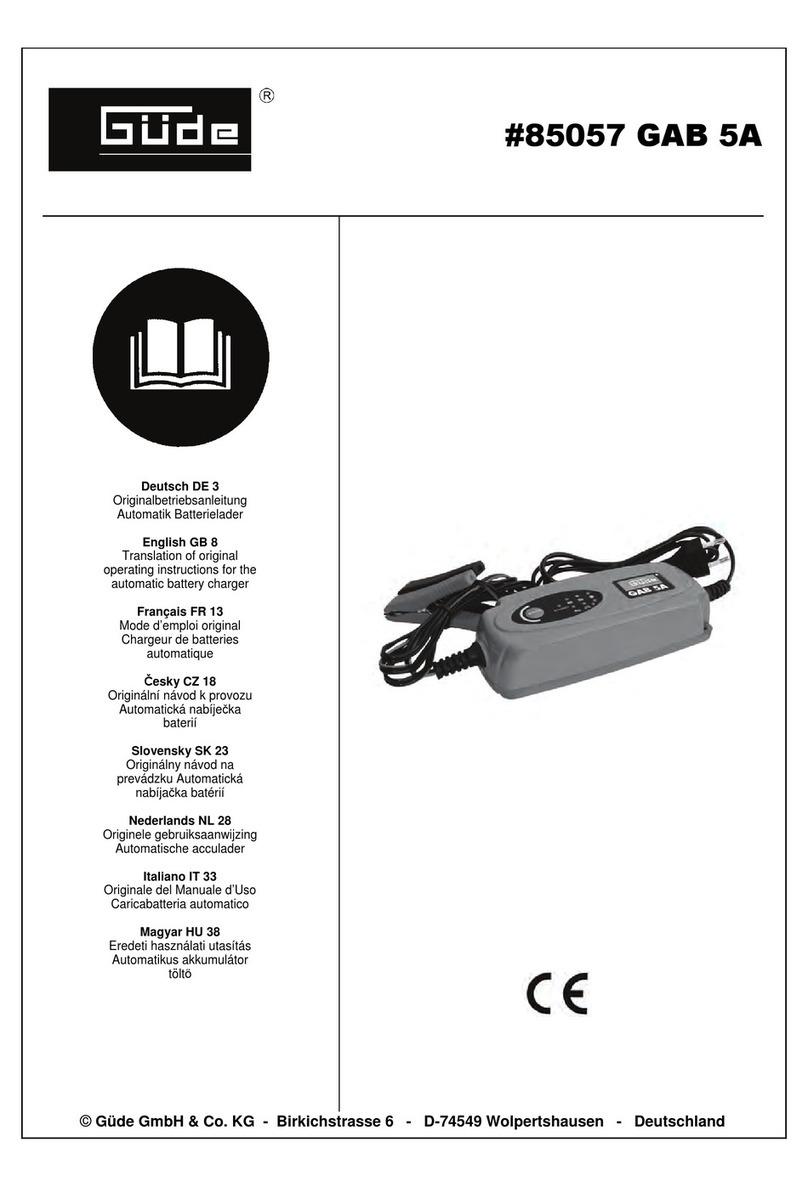
Gude
Gude 85057 GAB 5A User manual

Gude
Gude START 170 Wiring diagram

Gude
Gude GAB 8A User manual
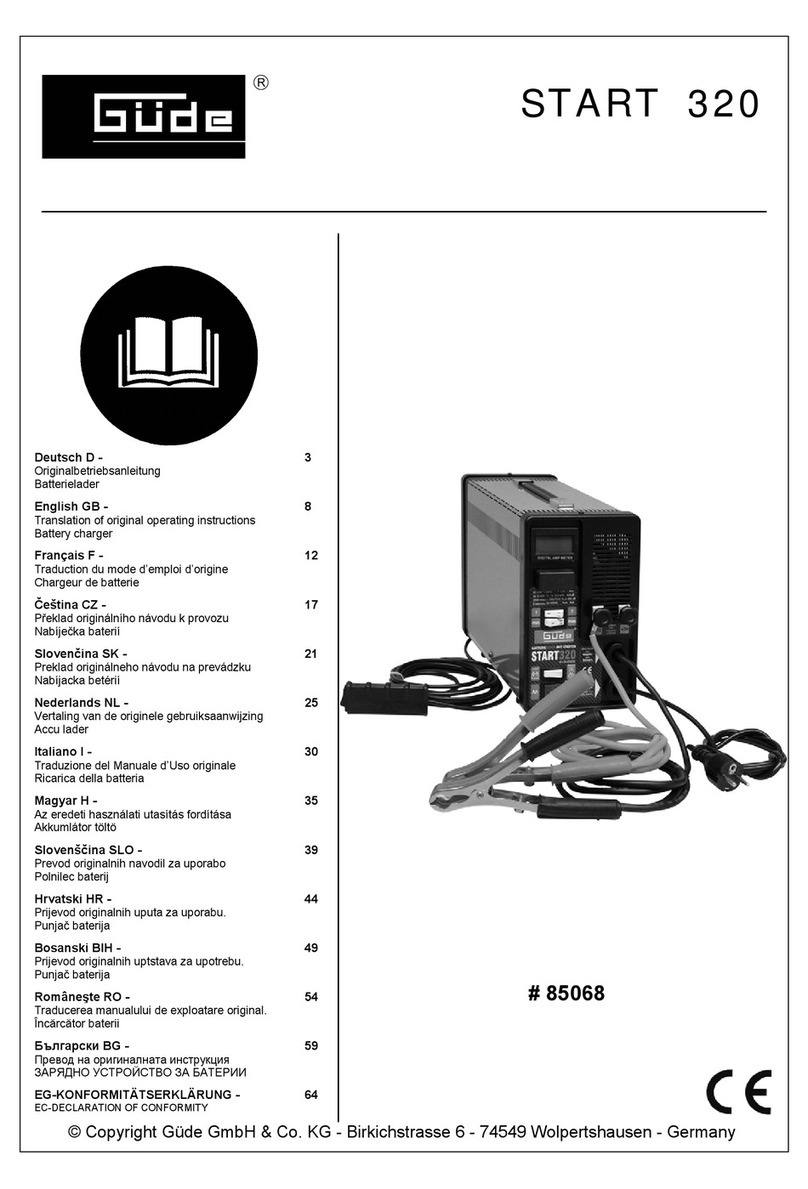
Gude
Gude START 320 Wiring diagram
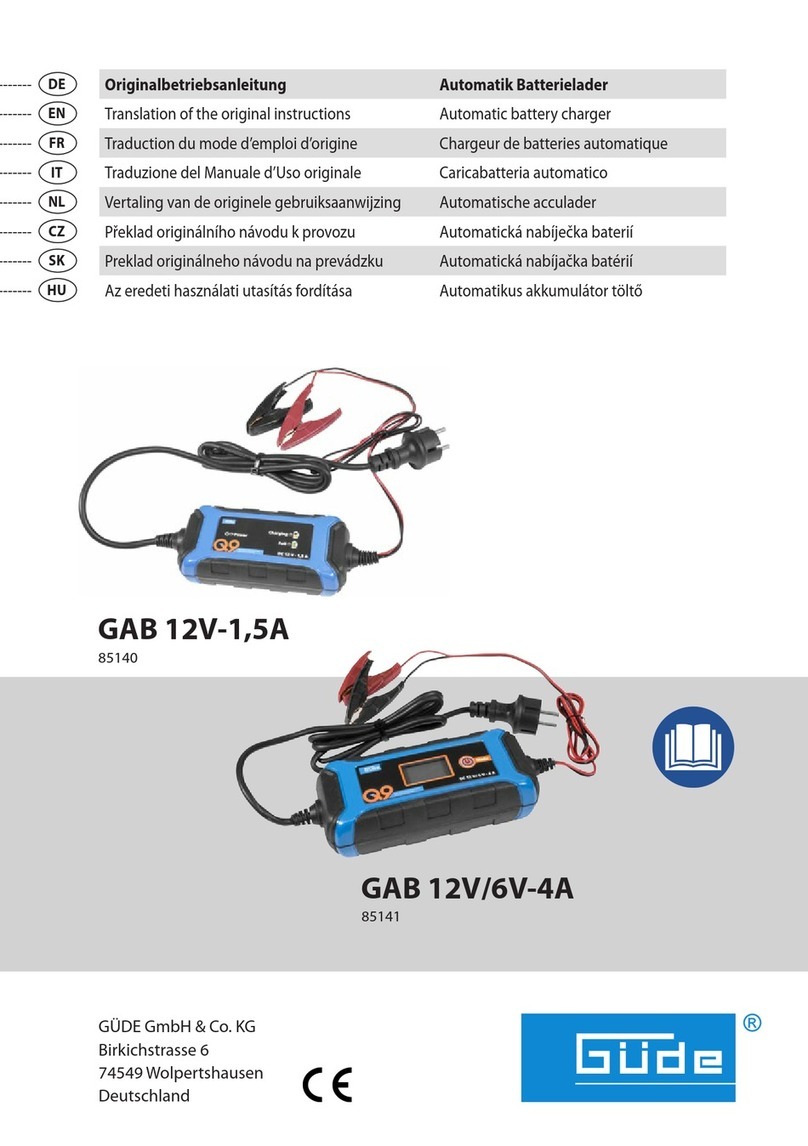
Gude
Gude GAB 12V-1,5A User manual
